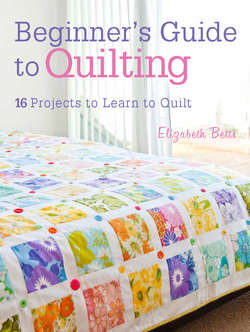Читать книгу Beginner's Guide to Quilting - Elizabeth Betts - Страница 10
На сайте Литреса книга снята с продажи.
ОглавлениеMaking a quilt sandwich
Once you have made your quilt top, the next stage is to make a quilt sandwich, so called as it has three layers – the backing, wadding (batting) and quilt top. As this is purely functional and not creative, it is my least favourite part of the quilt-making process, but it is essential to take time over it and get it right so you end up with a lovely, smooth quilt.
Sometimes it may be necessary to join pieces of fabric together to make a large enough piece of backing fabric. If you need to join two fabrics together, press the seams open so the fabric lies flat. It does not have to be the same fabric used – I really like the look of a quilt back which features more than one fabric. Alternatively, you can buy extra wide, craft-weight fabric.
Assembling the layers
1 Press the backing fabric, then lay it out on a table or floor, right side down. Smooth it out so it is flat. If I am working on a quilt larger than 1yd (1m), then it can be helpful to use low tack masking tape to secure the backing to a surface, which helps keep it flat while you work. Make sure it is not pulled too tight.
2 Lay the wadding (batting) on top. Smooth it so it is completely flat.
3 Take the quilt top, press it flat and snip off any loose threads.
4 Place the quilt top on the wadding (batting) and backing, ensuring it is positioned in the middle. I like to have an extra 4in (10.2cm) of wadding (batting) and backing on each side of my quilt top. This allows for any movement while quilting. Smooth again, so all three layers are flat.
5 Use quilter’s safety pins to hold the layers together. Starting in the centre, pin every 4–6in (10.2–15.2cm) in rows, to make a grid format. Alternatively, you can tack (baste) large stitches across the quilt sandwich in a grid format.
